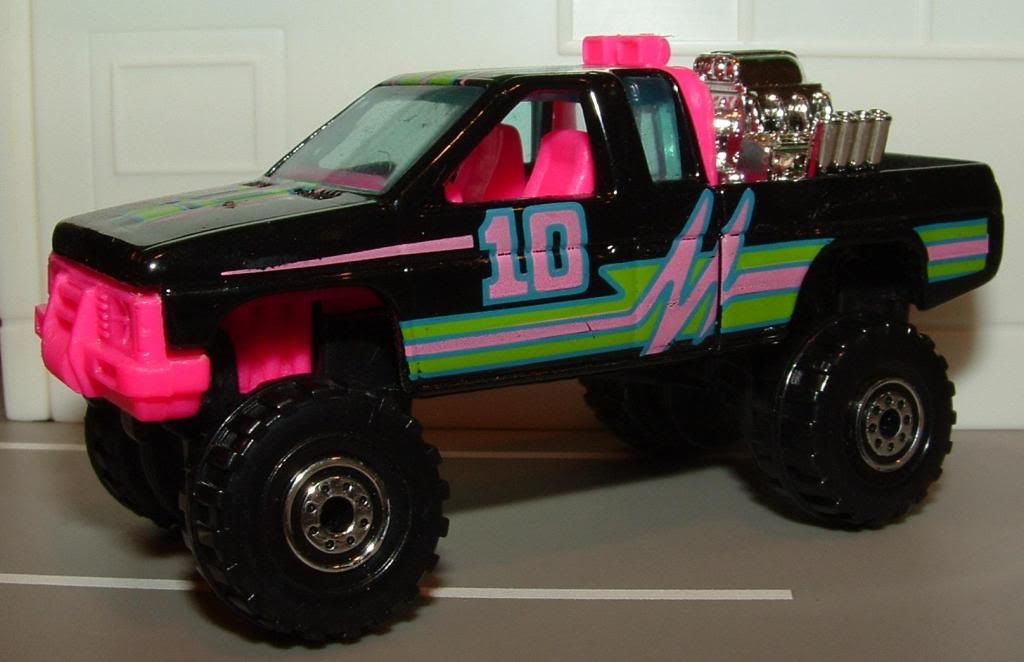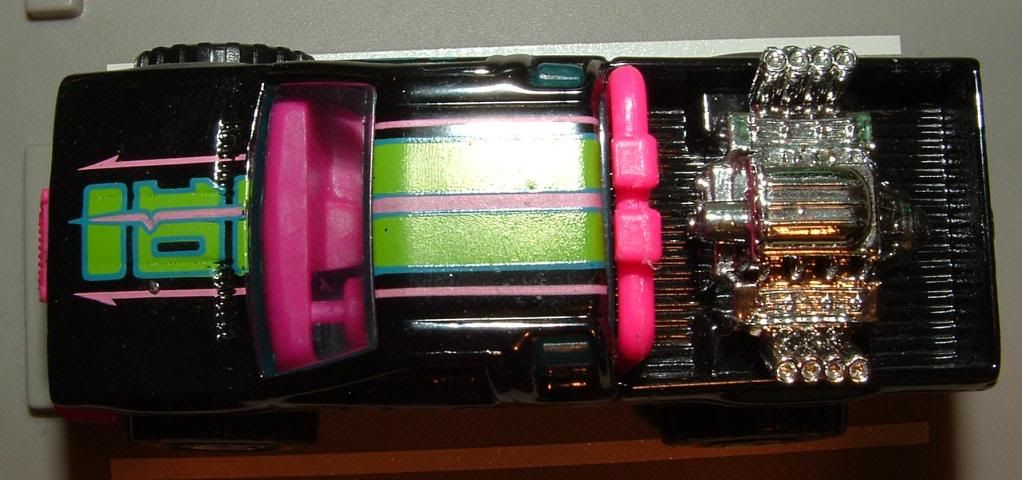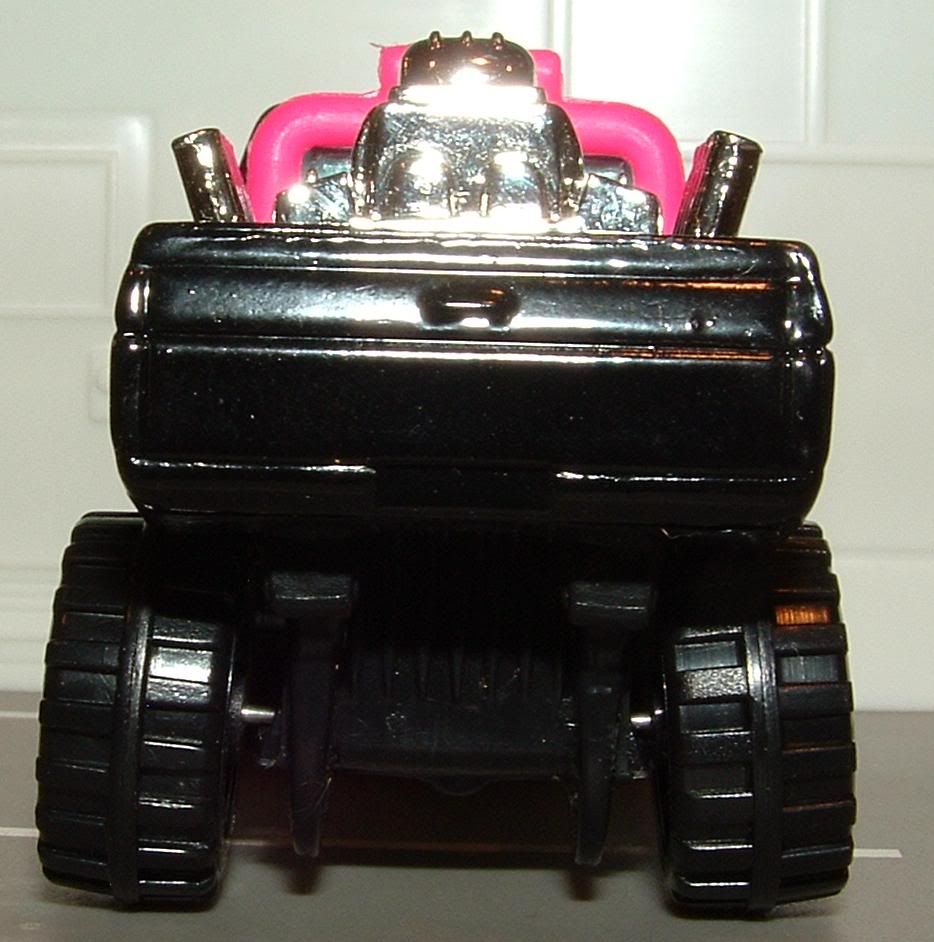
A blog focusing on 1/64 diecast from such popular brands as Hot Wheels, Matchbox, Johnny Lightning, M2 Machines, GreenLight, Tomica, Yat Ming, Majorette, MotorMax, Siku, Corgi, Guisval, Playart, Ertl, Zylmex, Racing Champions, & many more. Swifty's Garage features a daily Car Of The Day and news updates from your favorite brands!
Sunday, November 7, 2010
Truck Of The Day: November 7, 2010
Today's car of the day is Hot Wheels' 1987 Nissan Hardbody.
The D21 generation was the successor to the Datsun "720". The name, "Datsun" was still used by the company from 1980-83 then completely renamed itself, "Nissan" beginning with the 1983.5 model year line of trucks and cars alike. The D21 series were unofficially called, Nissan Hardbody in the United States.
The truck's name, "Hardbody", refers to its double-wall bed and overall styling. The Hardbody was produced for the U.S. Market from 1986.5 until 1997, and were direct competition to the Toyota compact pickup. The move from the 720 to the D21 Nissan series body style changed mid-year 1986.5 so the new 'D21' 1986.5 and later Hardbody can easily be distinguished from the earlier 720 body style by its two large headlights rather than four smaller lights and a less boxy, more aggressive appearance. The Nissan Pathfinder was derived from the Hardbody Truck and started in the same model year with chassis code WD21.
In the US, the Hardbody cab styles were 'Standard' and 'King' (also known as 'Extended'). Bed lengths were 'standard' 6-foot (2 m) and 'long' seven foot. International markets also received the 'Crew Cab' (4-door) version with a short four and a half foot bed. Both 4-cylinder and V6 engines were available, with the 2.4L 4 cylinder KA24E being a respectable-performance SOHC engine that replaced the Z24i for 1990-1997 utilizing a new 3 valve per cylinder head. The 6 cylinder 3.0L VG30E engine increased power and torque only modestly( Note: No VG30E V6's were produced beginning 1996 and the final year produced in the US 1997 models due to new emissions laws enacted with US OBD-II compliance that Nissan couldn't meet in time), only the KA24E 4cyl engine was available for 1996 and 1997 model years, for both 2 and 4 wheel drive configurations. Five-speed, including overdrive, manual transmissions were the most common, but an automatic transmission was an available option. Both rear wheel drive (4x2) and four wheel drive (4x4) versions were made in quantity. A limited slip differential was standard on the top 'SE' trim 4WD variants. Major options included air conditioning, larger wheels/tires, sliding rear window, stereo, and rear bumper. There were several trims available including base, XE, and top of the line SE. The XE could be ordered with a 'value package' starting in 1994 which included air conditioning, power mirrors, alloy wheels, and chrome on body trim such as the mirrors and bumpers. The SE was better equipped and could be ordered with the "sport power package" with sunroof, power windows, locks, and mirrors, air conditioning and special "Robot" alloy wheels. In 1993, Nissan had a strange model year crossover which utilized the dashboard of the 1986.5-1992 Model years with a slightly refreshened body appearance as well as some small interior changes and a revised instrument panel, and a first for the auto industry, compliance to the new R134A air conditioning refrigerant. 1994 would be the last major refresh through 1997. A new ergonomic dashboard and much improved interior arrived and added a driver side airbag. 1995 would be the first year to comply with the new, US, "DOT" enacted "high mount brake light" law requiring all trucks from all manufactures to mount a brake light in the center of the rear at the top of the cab. A passenger side airbag was added for 1996 as well as the newly enacted OBD-II Emissions system requirement. rear wheel ABS came with both 2WD and 4WD models beginning in 1991. Full Bosch 4 sensor (4 wheel) ABS would not be available until the "new" 1998 D22 series, "Frontier" pickups were released to the public.
For more information and pictures of the real car please visit: Nissan Hardbody Truck
For Ivan's benefit, this release has lightly tinted blue glass. I'm sure that's the most glaring fault on this one... I actually like this model and the few scrapes and chips were put into it by me. This one dates to my childhood (well, somewhere around 12-13 anyway) and survived pretty intact.
These low-cost, dependable Hardbody small pickup trucks sold very well worldwide, and are still often seen both on-road and off-road. They are renowned for their reliability and endurance, with the exception of body panel and frame rust over time. Other things to look for are a noisy timing chain on the 1990-1997 KA24E (2.4) 4cyl engine in particular which had a problem with the stock timing chain guides and slippers deteriorating, breaking off and allowing the timing chain to damage the timing cover, seizing the chain to the engine and/or timing cover, as well as damaging pistons and bending valves requiring serious engine work in extreme cases. This was remedied by buying aftermarket engine timing parts, (particularly the chain guide, slipper and tensioner), and repairing immediately when noises became apparent. Otherwise, the KA24E was an excellent engine. The V6 engine utilized a timing belt that requires replacing every 60K miles. Exhaust manifold studs were well known to fail prematurely due to heat embrittlement from poor materials quality, on all years from 1986.5- 1995. In the US, beginning in 1998, the new "D22" was officially named, "Frontier" and used a new DOHC 2.4 4cyl borrowed from the Nissan Altima. A newly modified "VG33" V6 was available in addition to the new 2.4 4cyl beginning in 1999 and ending production in the US in 2004. The new VG33E V6 had new, larger, 10mm exhaust manifold studs in an attempt to decrease the risk of premature exhaust manifold stud failure, but still had limited success.
In general however, the VG30E and VG33E V6's were both amazingly reliable engines.
The D22 is still being made in South Africa and elsewhere in the world.
The D21 design was still available new in some Latin American countries, made in Mexico until the 2008 model year. In its current home country a range of four basic variations of the D21 are sold together as the Nissan Camiones (literally "Nissan Trucks").
Subscribe to:
Post Comments (Atom)






No comments:
Post a Comment